Related Research Articles

The transport system in Malta is small but extensive, and the islands' domestic system of public transport is reliant on buses and taxis, although there were both a railway and a tramway in the past.

Valletta is the capital city of Malta and one of its 68 council areas. Located between the Grand Harbour to the east and Marsamxett Harbour to the west, its population as of 2021 was 5,157. As Malta’s capital city, it is a commercial centre for shopping, bars, dining, and café life. It is also the southernmost capital of Europe, and at just 0.61 square kilometres (0.24 sq mi), it is the European Union's smallest capital city.

The Athens Metro is a rapid-transit system in Greece which serves the Athens urban area. Line 1 opened as a single-track conventional steam railway in 1869 and was electrified in 1904. Beginning in 1991, Elliniko Metro S.A. constructed and extended Lines 2 and 3. It has significantly changed Athens by providing a much-needed solution to the city's traffic and air pollution problem, as well as revitalising many of the areas it serves. Extensions of existing lines are under development or tender, like the Line 2 extension to Ilion where tender started in 2023, as well as a new Line 4, whose central section began construction in October 2021. The Athens Metro is actively connected with the other means of public transport, such as buses, trolleys, the Athens Tram and the Athens Suburban Railway. The Athens Metro is hailed for its modernity, and many of its stations feature works of art, exhibitions and displays of the archaeological remains found during its construction. Photography and video-taking is permitted across the whole network and street photographers often work in Athens Metro. This will be the only metro system in Greece, until the Thessaloniki Metro begins operation in 2024.
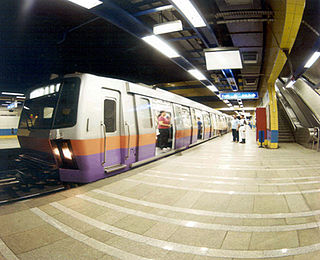
The Cairo Metro is a rapid transit system in Greater Cairo, Egypt. It was the first of the three full-fledged metro systems in Africa and the first in the Middle East to be constructed. It was opened in 1987 as Line 1 from Helwan to Ramses Square with a length of 29 kilometres (18.0 mi). As of 2013, the metro carried nearly 4 million passengers per day. As of 15 May 2024, the Cairo Metro has 84 stations of which 5 are transfer stations, with a total length of 106.8 kilometres (66.4 mi). The system consists of three operational lines numbered 1 to 3.

The Mumbai Metro is a rapid transit (MRT) system serving the city of Mumbai and the wider Mumbai Metropolitan Region in Maharashtra, India.

The Orange Line, also known as Line 2, is the longest and first-planned of the four subway lines of the Montreal Metro in Montreal, Quebec, Canada. It formed part of the initial network, and was extended from 1980 to 1986. On April 28, 2007, three new stations in Laval opened making it the second line to leave Montreal Island.

Metrorrey, officially Sistema de Transporte Colectivo Metrorrey, is a rapid transit system that serves the metropolitan area of Monterrey. It is operated by the Sistema de Transporte Colectivo Metrorrey, which is part of the decentralized public administration of Nuevo León. In 2022, it was the sixth largest metro system in North America by ridership.

The Kolkata Metro is a rapid transit system serving the city of Kolkata and the wider Kolkata Metropolitan Region in West Bengal, India. Opening in 1984, it was the first operational rapid transit system in India, beside being the second busiest and fourth-longest metro network in India. As of March 2024, it has four operational lines: the 32.13 km (19.96 mi) Line 1 from Dakshineswar to Kavi Subhash, 14.1 km (8.8 mi) Line 2 from Salt Lake Sector V to Howrah Maidan, 7.75 km (4.82 mi) Line 3 from Joka to Majerhat and 5.4 km (3.4 mi) Line 6 from Kavi Subhash to Hemanta Mukherjee for a total of 59.38 km (36.90 mi). Two other lines are in various phases of construction and planning. The system has a mix of underground, at-grade and elevated stations using both broad-gauge and standard-gauge tracks. Trains operate between 06:55 and 22:30 IST and the fares range from ₹5 to ₹50.
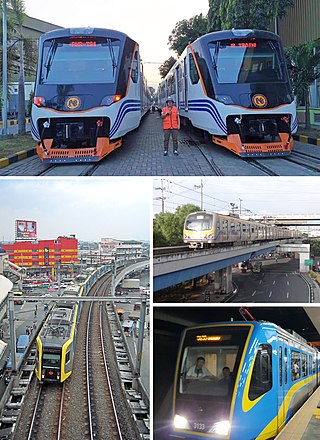
Rail transportation in the Philippines is currently used mostly to transport passengers within Metro Manila and provinces of Laguna and Quezon, as well as a commuter service in the Bicol Region. Freight transport services once operated in the country, but these services were halted. However, there are plans to restore old freight services and build new lines. From a peak of 1,100 kilometers (680 mi), the country currently has a railway footprint of 533.14 kilometers (331.28 mi), of which only 129.85 kilometers (80.69 mi) are operational as of 2024, including all the urban rail lines. World War II, natural calamities, underspending, and neglect have all contributed to the decline of the Philippine railway network. In the 2019 Global Competitiveness Report, the Philippines has the lowest efficiency score among other Asian countries in terms of efficiency of train services, receiving a score of 2.4, and ranking 86th out of 101 countries globally. The government is currently expanding the railway network up to 1,900 kilometers (1,200 mi) by 2022 through numerous projects.
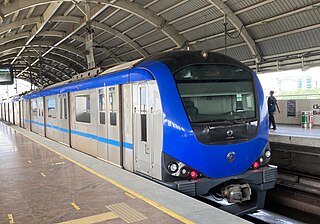
Chennai Metro is a rapid transit system serving the city of Chennai, India. As of April 2024, the operational network consists of two colour-coded lines covering a length of 54.1 km (33.6 mi) making it the fifth longest metro system in India. Chennai Metro Rail Limited (CMRL), a joint venture of Government of India and the Government of Tamil Nadu, built and operates Chennai Metro. The system uses standard gauge and has a mix of underground and elevated stations.

The Montreal Metro is a rubber-tired underground rapid transit system serving Greater Montreal, Quebec, Canada. The metro, operated by the Société de transport de Montréal (STM), was inaugurated on October 14, 1966, during the tenure of Mayor Jean Drapeau.

The Hyderabad Metro is a rapid transit system, serving the city of Hyderabad, Telangana, India. It is the third longest operational metro network in India after Delhi Metro and Namma Metro (Bengaluru), and the lines are arranged in a secant model. It is funded by a public–private partnership (PPP), with the state government holding a minority equity stake. Hyderabad Metro is the world's largest elevated Metro Rail system based on DBFOT basis. A special purpose vehicle company, L&T Metro Rail Hyderabad Ltd (L&TMRHL), was established by the construction company Larsen & Toubro to develop the Hyderabad metro rail project.

Lahore Metro is an automated rapid transit system in Lahore, Punjab, Pakistan and the first driverless metro in Pakistan. Three metro lines have been proposed, of which the Orange Line is operational. It is also Pakistan's first metro line system.

The MRT Purple line or MRT Chalong Ratchatham line is Bangkok's fifth rapid transit line, following the Sukhumvit Line, Silom Line, MRT Blue Line, and Airport Rail Link. The line is 23 km (14 mi) long, serving the north-western area of Bangkok running from Tao Poon to Klong Bang Phai in Nonthaburi Province.
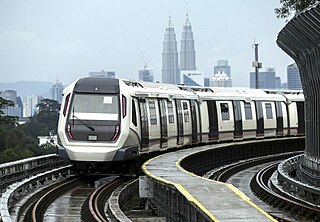
The MRT Kajang Line, previously known as the MRT Sungai Buloh–Kajang Line, is a Mass Rapid Transit (MRT) line servicing the Klang Valley, Malaysia. It is the second fully automated and driverless rail system in the Klang Valley region after the LRT Kelana Jaya Line. Owned by MRT Corp and operated as part of the Rapid KL system by Rapid Rail, it forms part of the Klang Valley Integrated Transit System. The line is numbered 9 and coloured green on official transit maps.

Urban rail transit in India plays an important role in intracity transportation in the major cities which are highly populated. It consists of rapid transit, suburban rail, monorail, and tram systems.

The Delhi Metro is a mass rapid transit system which serves Delhi and its adjoining satellite cities, such as Ghaziabad, Faridabad, Gurugram, Noida and Bahadurgarh, in the National Capital Region of India. The system consists of 10 colour-coded lines serving 256 stations, with a total length of 350.42 kilometres (217.74 mi). It is India's largest and busiest metro rail system and the second-oldest, after the Kolkata Metro. The metro has a mix of underground, at-grade, and elevated stations using broad-gauge and standard-gauge tracks. The metro makes over 4,300 trips daily.
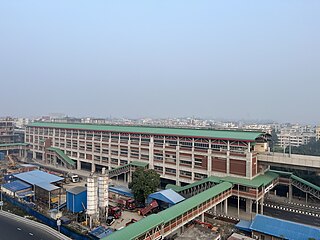
The Dhaka Metro Rail, or simply the Dhaka Metro, is a mass rapid transit system serving Dhaka, the capital and largest city of Bangladesh. It is owned and operated by the Dhaka Mass Transit Company Limited (DMTCL). Together with the under construction Dhaka BRT, proposed Dhaka Subway and Dhaka suburban circular rail, it is expected to reduce traffic congestion in the city. The metro rail network has five planned lines which are the MRT Line 6, the only operational line, MRT Line 1 and MRT line 5, which are under construction, and MRT Line 2 and MRT Line 4, which are in the planning stages. It is part of the Strategic Transport Plan outlined by the Dhaka Transport Coordination Authority (DTCA).
The Light Rail Transit Line 6 is a proposed rapid transit system in Cavite, Philippines. There have been two proposals for the line, with the first one shelved immediately in 2018. Another proposal emerged in 2017 and is currently under review by the National Economic and Development Authority (NEDA).
The city of Bristol in the United Kingdom has included a light rail transport system in its plans from the 1980s onwards. There has been no light rail in the city since the closure of Bristol Tramways in 1941.
References
- ↑ Sammut, Michael; Savona-Ventura, Charles (1996). "Petrol Lead in a Small Island Environment". International Journal of Risk & Safety in Medicine. 9 (1): 33–40. doi:10.3233/JRS-1996-9104. PMID 23512022.
- ↑ "Updated | Tram services among alternative transport means being studied". Malta Today . 21 September 2016. Retrieved 2 October 2022.
- ↑ "Government unveils 25-station, €6.2 billion underground Metro proposal". Times of Malta . October 2021. Retrieved 2 October 2022.
- ↑ "Malta metro study proposes three-line network". Metro Report International . 16 October 2021. Retrieved 2 October 2022.
- ↑ "Red Line | Malta Metro". www.metro.mt. Retrieved 2 October 2022.
- ↑ "Green Line | Malta Metro". www.metro.mt. Retrieved 2 October 2022.
- ↑ "Blue Line | Malta Metro". www.metro.mt. Retrieved 2 October 2022.